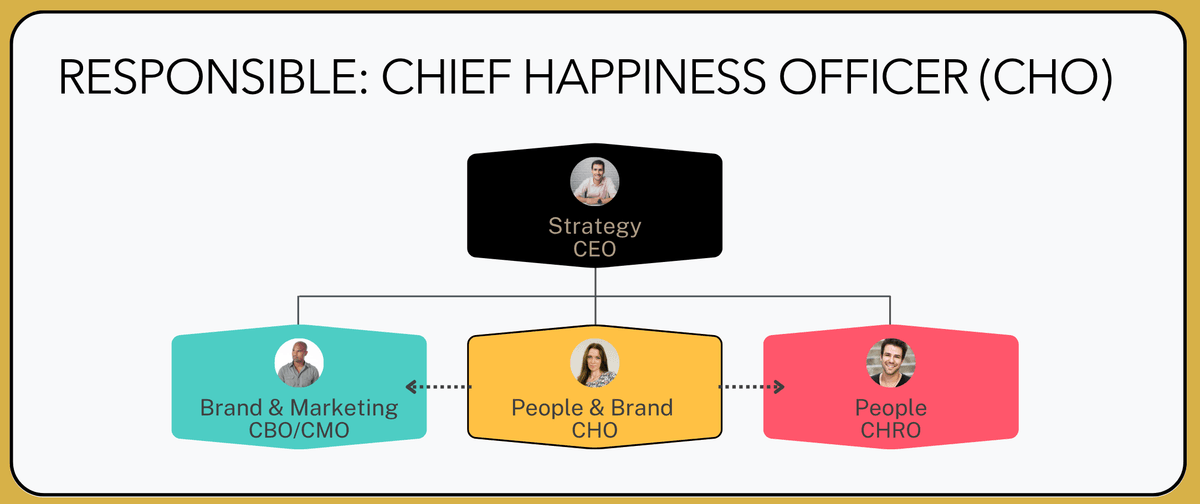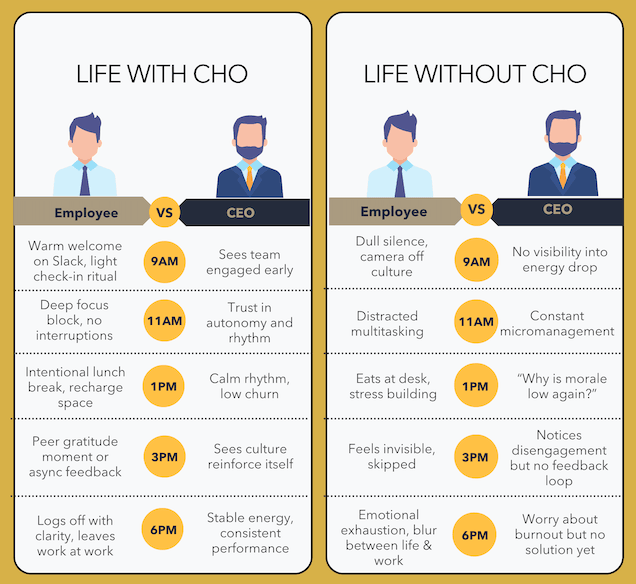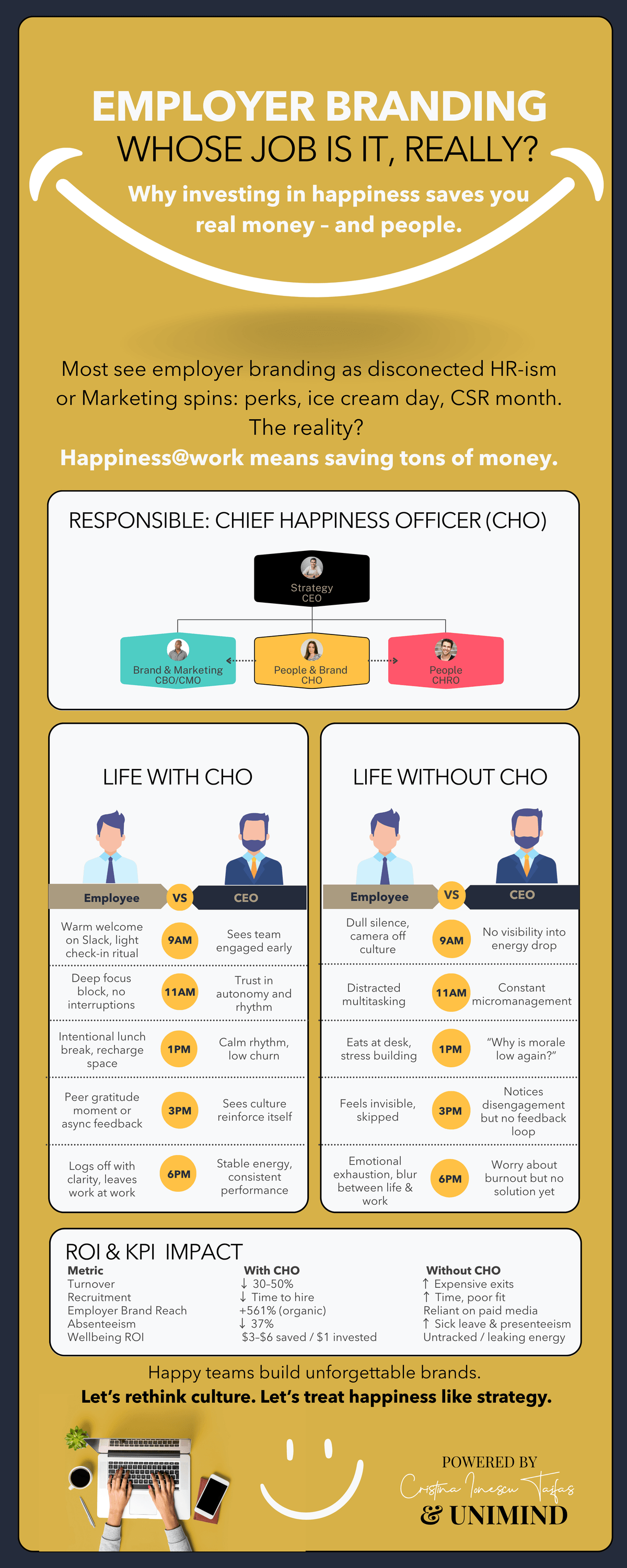You’ve seen it happen. A role opens. HR posts the job. Marketing adds a shiny visual. The CEO shares it once and moves on. Two weeks later: Zero strong applicants. Internal morale dips. Nobody’s talking about it, but everyone feels it: 👉 Your brand is loud outside, but hollow inside.
So, let’s ask the question that makes most leadership teams shift in their chairs:
Who actually owns employer branding?
🌬️ The Classic Myth
Most companies treatemployer branding like digital glitter:
✨ Social posts
✨ Open-space photos
✨ A “culture video” with b-roll hugs and coffee mugs
But behind thevisuals, there’s confusion: Is it an HR job? A marketing thing? A CEO initiative?
No one really ownsit—so it floats. Pretty,directionless, and quietly expensive.
🧠 The Smart Reality
Let’s ground this in data:
- Replacing an employee costs up to 200% of their annual salary SHRM
- Disengaged teams cost the global economy $8.8 trillion/year Gallup, 2023
- 65% of employees who feel recognized say they’d stay longer Gallup
So no—employerbranding isn’t a marketing banner. It’s not a Fridayemail or an onboarding slideshow. It’s a system. A living, breathingexperience shaped by three essential forces:
HR. Marketing. The CEO.
And increasingly, one emerging role that ties it all together: 👉 The Chief Happiness Officer (CHO)

🎯 The Three Impact Zones
When people say “employer branding”, most think about perks, videos, or branding slogans. But real impact happens at three deeper levels:
🧩 1. HR – Where everything starts (and leaks)
Recruitment. Retention. Recognition. These are not just HR tasks—they’re emotional transactions. People don’t quit jobs. They quit cultures that ignore them. “We didn’t lose talent. We lost trust.”
- 🔍 Over 50% of employee exits could be prevented
- 🔍Recognized employees are 65% less likely to leave → Gallup: Retention
Done right, employer branding turns your workplace into a magnet—not a filter. People stay. People grow. And word spreads.
📣 2. Marketing – Where real influence lives
Forget the paid campaigns for a second. Your most powerful brand asset isn’t in your ads. It’s in your people. What they say. What they post. How they feel when they’re off mute.
You don’t need bigger reach. You need real voices—amplified with pride.
🌱 3. Culture – Where magic (or misery) happens
Culture isn’t a mural in reception. It’s what people whisper in DMs. It’s how Monday feels. It’s whether“off-camera” is a relief—or a survival mode. And it’s measurable:
- 🔍Engaged teams = 43% more productivity
- 🔍 Every $1 in wellbeing = $3–$6 in savings (absenteeism, burnout) → HBR
So no, it’s not about yoga classes. It’s about how it feels to work here. And what that feeling does to performance.
🧠 But Wait—The Workforce Has Changed
5–10 years ago, GenX and Boomers made up over 35–40% of the workforce. Today, Millennials and Gen Z make up nearly 60%, and by 2030, Gen Alpha will join in.→ Deloitte
And here’s the catch: This new majority doesn’t care about beer fridges and once-a-year team buildings. They want:
✅ Meaningful work
✅ Work-life balance
✅ Psychological safety
✅ Leaders whocare about how it feels tobe part of something
In fact:
So if employer branding still looks like “ice cream day” and “CSR month,” you’re speaking the
wrong language to the next 20 years of your workforce.
🔁 Now Let’s Flip the Script (Simon Sinek-style)
💡 WHY – Why happiness at work matters
Imagine a Monday morning that doesn’t start with tension. You wake up and know you’ll be stretched, yes—but not depleted. You walk into (or log into) a culture that values your energy, not just your output. That’s the promise of a workplace designed for humans. Not perfection. But intention.
🔧 HOW – With a CHO in the org chart
The Chief Happiness Officer isn’t a party planner. They’re a strategist of emotion, belonging, and experience. They sit near the CEO. Collaborate with HR, Marketing, IT, Operations, Facilities. And they ask: “How does it feel to work here—and how could it feel better?”
They don’t just manage perks. They shape the vibe. Because culture is not a “nice-to-have.” It’s your operating system.
🎁 WHAT – What changes with a CHO?

📊 Bottom Layer – ROI & KPIs Summary

🗝️ Final Thought
Employer branding isn’t a mood board. It’s not a slogan. It’s not a slide in your board deck.
It’s a human strategy. And the companies that get it……don’t just attract talent. They keep it. They grow it. And they turn it into brand equity from the inside out.
So let’s ask again: 👉 Who really owns your employer brand?
🧠 And what would happen if happiness became a business metric?
👇 Share your thoughts.
🫶 Or tagsomeone who should be yourfuture CHO.
Because happy teams build unforgettable brands. And it’s time we started acting like it.
💬 Let’s rethink culture. 📊 Let’s treat happiness like strategy.


